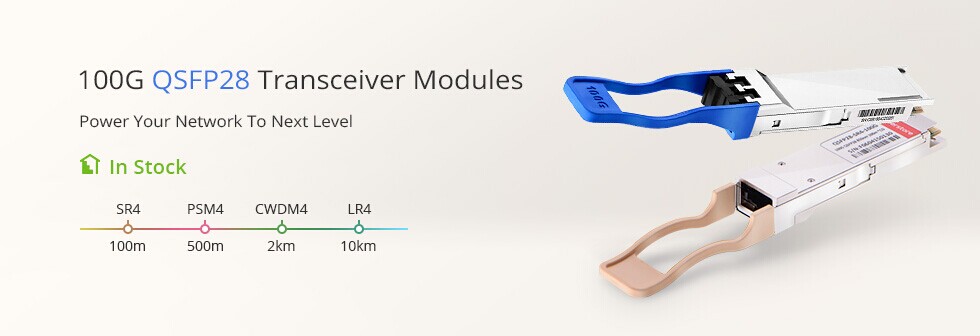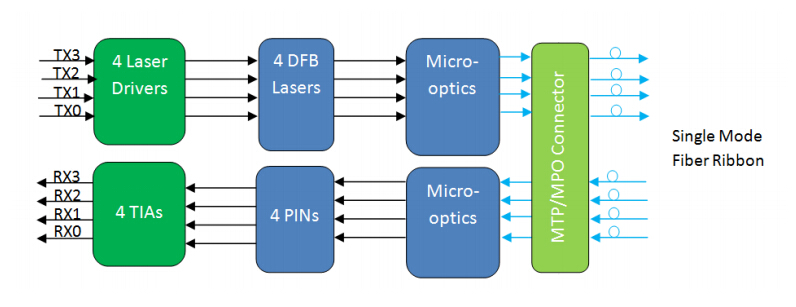QSFP 100G PSM4 s optics is a type of 100G QSFP28 single mode transceiver that provides a low-cost solution to long-reach data center optical interconnects. 100G PSM4 (parallel single mode 4 lane) standard is mainly targeted to data centers that based on a parallel single mode infrastructure for a link length of 500 m. Compared with the hot-selling 100G-SR4 and 100G-LR4 optics, QSFP 100G PSM4 s recently wins the popularity among the overall users. This article will provide a complete specification of the QSFP 100G PSM4 s transceiver and explain the reason why people would need QSFP 100G PSM4 s.

QSFP 100G PSM4 s—A Low-Cost but Long-Reach 100G Single Mode Transceiver
QSFP 100G PSM4 s is compliant with 100G PSM4 MSA standard, which defines a point-to-point 100 Gb/s link over eight parallel single mode fibers (4 transmit and 4 receive) up to at least 500 m. PSM4 uses four identical lanes per direction. Each lane carries a 25G optical transmission. The 100G PSM4 standard is now available in QSFP28 and CFP4 form factor. Table 2 shows the diagram of the QSFP 100G PSM4 s specification. 100G PSM4 is a low-cost solution. Its cost structure is driven by the cost of the fiber and the high component count. FS.COM offers the Cisco compatible QSFP 100G PSM4 s at US$750.00.

As you can see in the above image, QSFP 100G PSM4 s transceiver uses four parallel fibers (lanes) operating in each direction, with transmission distance up to 500 meters. The source of the QSFP 100G PSM4 s module is a single uncooled distributed feedback (DFB) laser operating at 1310 nm. It needs either a directly modulated DFB laser (DML) or an external modulator for each fiber. The 100GBASE-PSM4 transceiver usually needs the single mode ribbon cable with an MTP/MPO connector.
Why Do We Need QSFP 100G PSM4 s?
100G PSM4 is the 100G standard that has been launched by multi-source agreement (MSA) to enable 500m links in data center optical interconnects. But as we all know, there are several popular 100G interfaces out there on the market, such as QSFP28 100GBASE-SR4, QSFP28 100GBASE-LR4, QSFP28 100GBASE-CWDM4, and CFP 100GBASE-LR4, etc. So with so many options, why do we still need QSFP 100G PSM4 s?
To better help you make up your mind, you need to figure out the following questions:
Q1: What are the net link budget differences between PSM4, SR4, LR4 and CWDM?
Table 3 displays the detailed information about these 100G standards.
| 100GBASE-PSM4 | 100GBASE-CWDM4 | 100GBASE-SR4 | 100GBASE-LR4 | |
| 4-wavelength CWDM multiplexer and demultiplexer | No need | Need | No need | Need |
| Connector | MPO/MTP connector | Two LC connectors | MPO/MTP connector | Two LC connectors |
| Reach | 500 m | 2 km | 100 m | 10 km |
Note: the above diagram excludes the actual loss of each link (it is the ideal situation). In fact, WDM solution are at least 7 db worse link budget than PSM4. For a 2 km connectivity, a CWDM module will have to overcome about 10 db additional losses compared to PSM4. And the 100G LR4 optics at 10 km is 12 db higher total loss than PSM4.
Q2: What power targets are achievable for each, and by extension what form factors?
According to the IEEE data sheet, the WDM solutions cannot reasonably fit inside QSFP thermal envelop, while PSM4 can fit inside the QSFP thermal envelope. That means you would need the extra power for the WDM solution of your network. But if you use the QSFP PSM4, this won’t be a problem.
All in all, a QSFP 100G PSM4 s transceiver with 500m max reach is a optional choice for customers. Because other 100G optics are either too short for practical application in data center or too long and costly. QSFP 100G PSM4 s modules are much less expensive than the 10 km, 100GBASE-LR4 module, and support longer distance than QSFP 100G PSM4 s.
Summary
QSFP 100G PSM4 s is the lowest cost solution at under one forth the cost of either WDM alternatives. QSFP 100G PSM4 s can support a link length of 500 m, which is sufficient for data center interconnect applications. QSFP 100G PSM4 s also offers the simplest architecture, the most streamlined data path, higher reliability, an easy upgrade path to 100G Ethernet.
